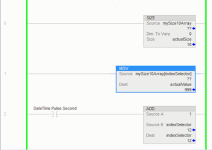drbitboy
Lifetime Supporting Member
Binary insertion sort is straightforward (e.g. see here), with the shift as a single step via the COP instruction.
It would have to work backwards from the top of the array, because overlapping COP forward overwrites all values in a sequence after the first.
But I still think @5618's example is the best here.
It would have to work backwards from the top of the array, because overlapping COP forward overwrites all values in a sequence after the first.
But I still think @5618's example is the best here.






